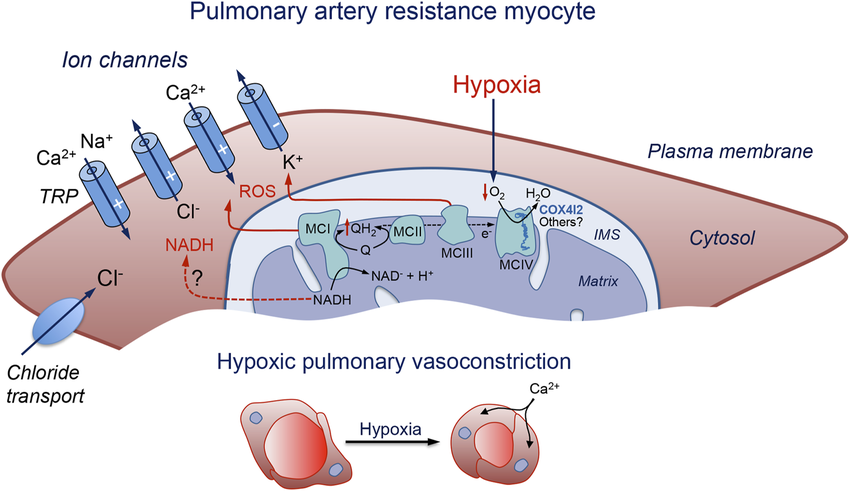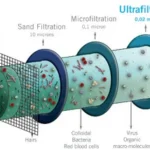Hypoxic Pulmonary Vasoconstriction (HPV) is the lung’s local reflex: when a region of the lung has low oxygen in the alveoli, the small blood vessels feeding that region constrict. That redirects blood to better-ventilated lung units so more blood meets oxygen — it’s a built-in V/Q (ventilation–perfusion) matching tool. This opposite reaction (pulmonary constriction vs systemic dilation in hypoxia) makes the pulmonary circulation special.
The unusual rule of the lungs
In most of the body, when tissues are low on oxygen, blood vessels open up (dilate) to bring more oxygen.
But in the lungs, the opposite happens: low oxygen makes small arteries narrow (constrict).
Why?
Because the lung’s job is to match airflow (ventilation) with blood flow (perfusion). If one area of the lung isn’t getting air, it makes no sense to send blood there — that blood would leave still “blue” and waste circulation. So, the lung redirects blood to regions that are better ventilated. That redirection is hypoxic pulmonary vasoconstriction.
Where it happens (anatomy, simply)
- The important sites are the tiny arteries and arterioles that run right beside the alveoli (air sacs).
- The muscle cells in their walls — called pulmonary artery smooth muscle cells (PASMCs) — are the “motors” that tighten or relax.
- Endothelial cells, which line the vessels, act as “regulators” that release chemical signals to fine-tune the constriction.
Think of it like a road system: the PASMCs are the gates that open or close lanes, and the endothelial cells are the traffic lights that coordinate timing.
How the lung senses oxygen levels
The lung doesn’t have a single oxygen sensor like a thermometer. Instead, the PASMCs sense oxygen through their mitochondria (the energy factories of the cell).
Here’s the simplified version:
- Under normal oxygen, mitochondria use oxygen to run the electron transport chain.
- Under low oxygen, the chemistry shifts. Reactive oxygen species (ROS) and other redox signals change.
- Those changes are the signal that oxygen is low.
So mitochondria whisper to the cell: “Oxygen is dropping — time to tighten up.”
The chain reaction inside smooth muscle cells
Let’s break the cascade down in order, using everyday analogies.
- Potassium channels close
- Normally, tiny pores let potassium (K⁺) leak out of the muscle cell, keeping the inside slightly negative.
- Low oxygen makes these pores close.
- Analogy: imagine plugging the drain in a sink — charge builds up inside.
- Cell depolarizes
- With K⁺ trapped, the inside of the cell becomes more positive.
- That change in “voltage” is like flipping a switch.
- Calcium channels open
- Voltage-gated calcium (Ca²⁺) channels now open.
- Calcium rushes into the cell like water flooding in when you open a gate.
- Muscle contracts
- Calcium binds to calmodulin → activates an enzyme called MLCK (myosin light-chain kinase).
- MLCK phosphorylates myosin → myosin grabs actin → the smooth muscle cell shortens → the vessel narrows.
So the entire story is: low oxygen → close K⁺ channels → depolarization → open Ca²⁺ channels → more calcium → contraction.
How the endothelium fine-tunes it
The endothelial cells add another layer:
- Nitric oxide (NO): relaxes smooth muscle. Less NO = stronger constriction.
- Endothelin-1: tightens vessels. More endothelin = stronger constriction.
These two work like pedals in a car: NO is the brake, endothelin is the accelerator. Together they adjust how much constriction actually happens.
Acute vs. chronic hypoxia
- Acute HPV (seconds–minutes): helpful. It quickly redirects blood to healthier lung regions.
- Chronic HPV (days–months): harmful. If the whole lung is hypoxic (for example, at high altitude or in chronic lung disease), all vessels constrict. Pressure in the pulmonary circulation rises, leading to pulmonary hypertensionand eventually right-sided heart failure.
At this stage, not just ion channels but also long-term changes occur: smooth muscle cells grow more muscle, vessels thicken, and the Rho-kinase pathway makes contractions stronger even at the same calcium level.
Clinical importance
- Ventilation–perfusion (V/Q) matching: HPV keeps oxygenation efficient at rest. Without it, blood would waste time going to collapsed or blocked regions.
- One-lung ventilation in surgery: When one lung is deflated during chest surgery, HPV minimizes shunting by redirecting blood to the ventilated lung.
- Anesthesia: Some anesthetic gases weaken HPV, leading to poor oxygenation during operations.
- High altitude: At high altitudes, global HPV can raise pressures and cause high-altitude pulmonary edema.
- Chronic lung disease (COPD, fibrosis): Chronic hypoxia → persistent HPV → pulmonary hypertension → right-sided heart failure (cor pulmonale).
Everyday analogy to remember
Imagine a hotel with 100 rooms (alveoli) and a cleaning staff (blood).
- Some rooms are locked and dirty (poor ventilation, low oxygen).
- The manager (lung) tells the staff: “Don’t waste time on those rooms — go clean the open, usable ones.”
That’s exactly what HPV does.
Quick Recap
- HPV = low alveolar oxygen makes nearby arteries constrict.
- Happens in small pulmonary arteries/arterioles near alveoli.
- Oxygen sensing = mitochondrial redox changes.
- Cascade = close K⁺ channels → depolarization → Ca²⁺ influx → smooth muscle contraction.
- Endothelium adjusts with NO (relax) and endothelin (tighten).
- Acute = useful, chronic = harmful (pulmonary hypertension).


